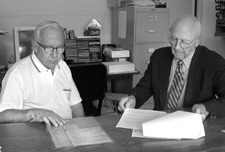

Polly, Roat react to book
By JEFF LESTER, Senior Writer November 16, 2004
 |
Brownie Polly Jr., left, shows George Roat news clippings on a 1934 Derby mine explosion in which Polly's father helped rescue more than 70 miners |
BIG STONE GAP - Brownie Polly Jr. and George Roat think Dan Rottenberg has written a very good broad history of the American coal industry, centered on five generations of the Leisenring family's ownership of coal companies. "I think it's excellent," said Roat of the book, "In the Kingdom of Coal." Both men have plenty of personal experience with the Leisenrings' management of Stonega Coke & Coal and Westmoreland Coal in this region. Polly's father was a superintendent for Stonega, and Roat ran Central Supply Co., a Stonega/Westmoreland subsidiary, for three decades. In a Monday interview, Polly and Roat agreed that Rottenberg's book taught them much that they didn't know about the early history of the Leisenring companies in eastern and western Pennsylvania.
Both noted that, like local historian Lawrence Fleenor, they found a handful of factual inaccuracies. "But they're not significant," Polly said. The factual mistakes would be spotted by people who have a long familiarity with this region, and not by other readers, he said.
For example, Rottenberg describes a now-legendary 1934 mine explosion at Derby that trapped 91 miners underground, killing 17. Brownie Polly Sr., the mine superintendent, is credited with leading a rescue effort that saved the remaining 74 miners.
In the book, Rottenberg writes that Polly was in the mine office over the company store, about 800 feet from the mine entrance, when it blew. In fact, Brownie Polly Jr. says, the company store was a mile away, and the mine office was in a separate building.
The elder Polly went to the "doghole" - a small opening used to drain water from the mine, about one-half mile from the entrance - and found that, purely by coincidence, two men were digging to widen it, with no knowledge of the explosion. Against a foreman's advice, Polly insisted on entering the doghole, which was flooded with water as high as one foot below the "top," or roof, his son said.
Polly disappeared in the darkness for nearly three hours, then emerged, leading dozens of men out to safety.
Another minor mistake was Rottenberg's note that former Westmoreland CEO Ted Leisenring Jr. began his career in 1949 in Stonega's engineering department on the fifth floor of the Miner Building - which has only three floors. Polly worked there as well for three summers while attending college, he said.
Roat and Polly also noted that the book does not mention a few major figures in Stonega and Westmoreland over the years - such as Westmoreland president of eastern coal development Harry Meador Jr., for whom Big Stone Gap's coal museum is named, and Howard Frey, who was Westmoreland's president for several years before Leisenring retired as CEO in 1988 and turned operations over to Pemberton Hutchinson.
Polly is a retired dentist who has been active in local civic and economic development for decades. His brother George Polly is the Big Stone Gap town manager.
Roat, a native of Philadelphia, worked in the Pennsylvania coal industry before Stonega recruited him to Virginia in 1954.
At that time, Central Supply, founded in the 1920s, was the purchasing agent for Stonega, and did 95 percent of its business with Stonega or Westmoreland. Central Supply furnished the companies with everything from roof bolts to mining machinery.
Under Roat's 32-year leadership, Central Supply expanded to five warehouses in Virginia, West Virginia and Kentucky, with about 60 percent of its business coming from other coal companies, he said.
A few years after Roat's 1986 retirement, Westmoreland sold Central Supply to the United Company. It has been sold at least once since then, he said.
Roat and Polly agree that there was tremendous apprehension in this part of Wise County during the mid-1990s as Westmoreland faced massive financial problems and finally closed its Virginia operations, laying off 650 remaining employees. "There used to be the feeling that if they left, everything would go to hell," Roat said.
But both said Big Stone Gap has rebounded well from the 1995 loss of what had been its most dominant employer for more than 100 years.
A quarter-century before Westmoreland pulled out, town leaders had already planted the seeds for greater economic diversity by pushing for creation of Wellmont Lonesome Pine Hospital, Mountain Empire Community College and Heritage Hall Nursing Home, Polly said. Also, Wallens Ridge State Prison and the state Department of Mines, Minerals and Energy employ hundreds locally, he noted.
Appalachia continues to struggle for a clear path to the future, Polly and Roat agreed.
Polly said the town was perhaps Wise County's busiest up to the early 1950s, when Stonega sold its nearby coal camps to their residents and began shutting down large mines. Appalachia has suffered a long, slow decline since then and faces a more difficult transition than Big Stone Gap, he said.
©Coalfield.com 2004
The End